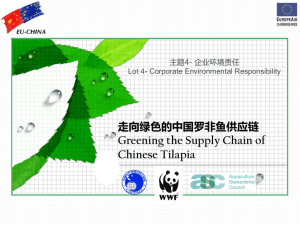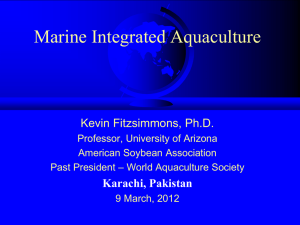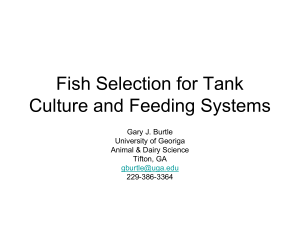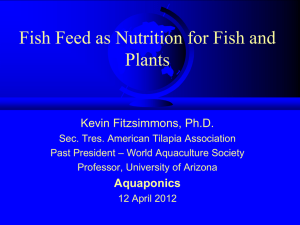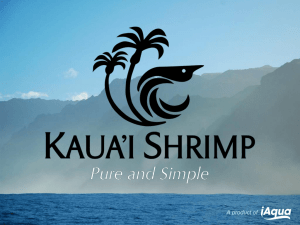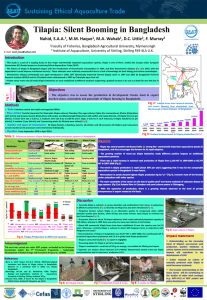STOCKING DENSITIES OF NILE TILAPIA IN TILAPIA
advertisement
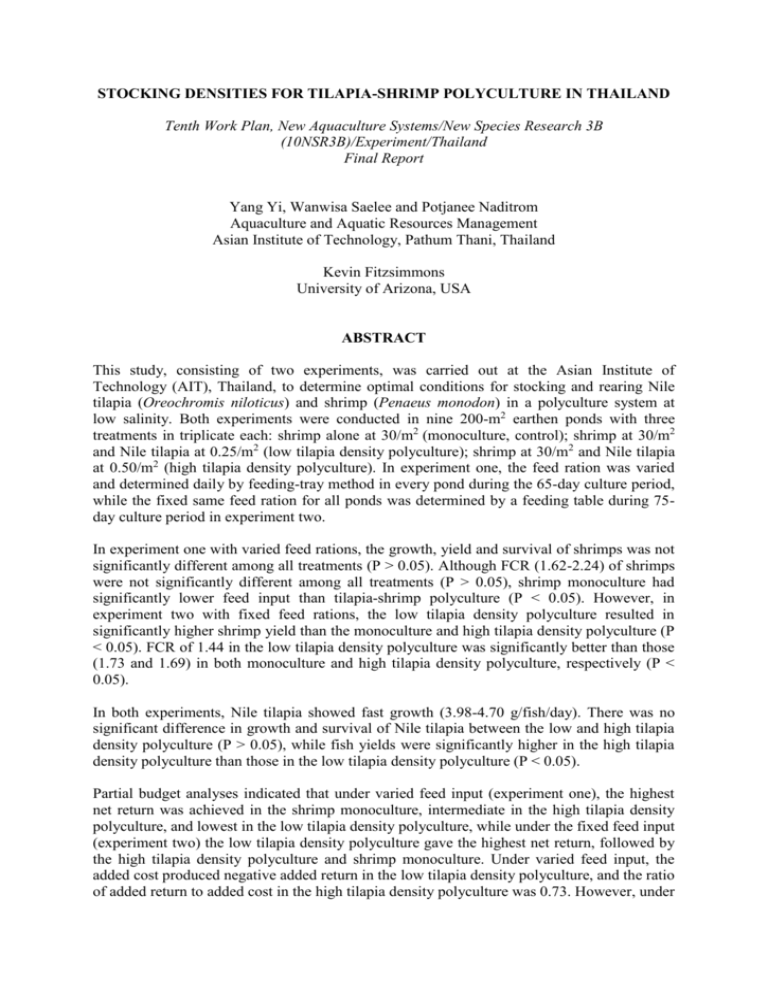
STOCKING DENSITIES FOR TILAPIA-SHRIMP POLYCULTURE IN THAILAND Tenth Work Plan, New Aquaculture Systems/New Species Research 3B (10NSR3B)/Experiment/Thailand Final Report Yang Yi, Wanwisa Saelee and Potjanee Naditrom Aquaculture and Aquatic Resources Management Asian Institute of Technology, Pathum Thani, Thailand Kevin Fitzsimmons University of Arizona, USA ABSTRACT This study, consisting of two experiments, was carried out at the Asian Institute of Technology (AIT), Thailand, to determine optimal conditions for stocking and rearing Nile tilapia (Oreochromis niloticus) and shrimp (Penaeus monodon) in a polyculture system at low salinity. Both experiments were conducted in nine 200-m2 earthen ponds with three treatments in triplicate each: shrimp alone at 30/m2 (monoculture, control); shrimp at 30/m2 and Nile tilapia at 0.25/m2 (low tilapia density polyculture); shrimp at 30/m2 and Nile tilapia at 0.50/m2 (high tilapia density polyculture). In experiment one, the feed ration was varied and determined daily by feeding-tray method in every pond during the 65-day culture period, while the fixed same feed ration for all ponds was determined by a feeding table during 75day culture period in experiment two. In experiment one with varied feed rations, the growth, yield and survival of shrimps was not significantly different among all treatments (P > 0.05). Although FCR (1.62-2.24) of shrimps were not significantly different among all treatments (P > 0.05), shrimp monoculture had significantly lower feed input than tilapia-shrimp polyculture (P < 0.05). However, in experiment two with fixed feed rations, the low tilapia density polyculture resulted in significantly higher shrimp yield than the monoculture and high tilapia density polyculture (P < 0.05). FCR of 1.44 in the low tilapia density polyculture was significantly better than those (1.73 and 1.69) in both monoculture and high tilapia density polyculture, respectively (P < 0.05). In both experiments, Nile tilapia showed fast growth (3.98-4.70 g/fish/day). There was no significant difference in growth and survival of Nile tilapia between the low and high tilapia density polyculture (P > 0.05), while fish yields were significantly higher in the high tilapia density polyculture than those in the low tilapia density polyculture (P < 0.05). Partial budget analyses indicated that under varied feed input (experiment one), the highest net return was achieved in the shrimp monoculture, intermediate in the high tilapia density polyculture, and lowest in the low tilapia density polyculture, while under the fixed feed input (experiment two) the low tilapia density polyculture gave the highest net return, followed by the high tilapia density polyculture and shrimp monoculture. Under varied feed input, the added cost produced negative added return in the low tilapia density polyculture, and the ratio of added return to added cost in the high tilapia density polyculture was 0.73. However, under fixed feed input, the ratio of added return to added cost in the low tilapia density polyculture reached 22.69, which is higher than that (5.04) in the high tilapia density polyculture. The present study indicated that the addition of Nile tilapia into shrimp ponds can improve feed utilization efficiency, resulting in better economic returns and less environmental pollution. The present study showed that the tilapia-shrimp polyculture with appropriate feeding strategy is technically feasible, economically attractive and environmentally friendly. INTRODUCTION In Thailand, intensive culture of black tiger shrimp (Penaeus monodon) has been developed rapidly along the coastal area since 1987, and Thailand has been the world’s leading marine shrimp producer since 1991 (Fast and Menasveta, 2000). One of the major problems for Thai shrimp farmers in coastal areas is the disease outbreak such as white spot that often causes the failure of marine shrimp production. The success of shrimp culture at low salinity led to a rapid expansion of shrimp culture into many inland areas for reducing disease risk (Fast and Menasveta, 2000). Many shrimp ponds in coastal areas have been abandoned in Thailand and some other parts of the world due to diseases, poor management such as overstocking, and environmental degradation. The polyculture of shrimp-tilapia at relative low stocking density may provide an opportunity to develop a sustainable aquaculture system to best utilize abandoned shrimp ponds in coastal areas and low-salinity shrimp ponds in inland areas. In a polyculture setting, shrimp and tilapia can utilize different niches. In extensive culture, tilapia can filter feed on phytoplankton and zooplankton in the upper water column, while shrimp spend most of the time in the pond bottom grazing on bacterial films on the bottom substrate and on the detritus settling from above. In intensive culture receiving pelleted feeds, tilapia may monopolize the feed, especially for floating feed. However, some feed particles always get to the bottom where the shrimp will get it. More importantly, the fecal matter from the tilapia contributes to the detrial rain that supports the shrimp. Akiyama and Anggawati (1999) reported that yields of shrimp increased when red tilapia (Oreochromis spp.) were stocked into existing shrimp ponds. The author suggested that stocking rate was 20-25 g fish/ m2 and fish size at stocking was 50-100 g/fish. Akiyama and Anggawati (1999) reported that red tilapia assisted shrimp performance by improving and stabilizing the water quality, by foraging and cleaning the pond bottom and by having a probiotic type effect in the pond environment. Tilapia, as a filter feeder, can reduce excessive phytoplankton biomass in later stages of pond culture and recycle nutrients effectively (Stickney et al., 1979). Nile tilapia (O. niloticus) is the most commonly cultured species among tilapias in many countries such as Thailand. Although Nile tilapia is the least saline tolerant species among the commercially important tilapia species, Nile tilapia may be the tilapia species of choice in brackish water shrimp ponds, where the release of tilapia to estuaries is undesirable because Nile tilapia is unlikely to reproduce at salinities higher than 25 ppt (Teichert-Coddington et al., 1997). Therefore the purpose of this study was to determine optimal conditions for stocking and rearing tilapia and shrimp in a polyculture system at low salinity. METHODS AND MATERIALS Two experiments were conducted at the Asian Institute of Technology (AIT), Thailand for 65 and 75 days from 20 February to 26 April 2002 and from 27 November to 10 February 2003, respectively, to investigate growth performance of shrimp and Nile tilapia, and water quality at different stocking densities of Nile tilapia in tilapia-shrimp polyculture. Nine 200-m2 earthen ponds were used for each experiment. There were three treatments in triplicate each for both experiments: shrimp alone at 30/m2 (monoculture, control); shrimp at 30/m2 and Nile tilapia at 0.25/m2 (low tilapia density polyculture); shrimp at 30/m2 and Nile tilapia at 0.50/m2 (high tilapia density polyculture). Feed rations were varying in each pond and estimated by feeding trays (50 x 50 x 10 cm) daily in experiment one, while the same feed rations were used for all ponds in experiment two, which were determined by a typical feeding table (Lin, 1995) and the estimated average shrimp survival in experiment one. Juvenile shrimps (PL15) were nursed in a 200-m2 earthen pond at AIT for 45 days prior to both experiments. The nursed shrimps (0.4-1.2 g) were stocked in all experimental ponds on 20 February 2002 for experiment one and 27 November 2002 for experiment two, while sexreversed male Nile tilapia fingerings (5.5-8.0 g) were stocked 7 days after stocking shrimp. Prior to the start of the experiments, all ponds were drained completely and dried for 2 weeks, and filled with freshwater from a nearby canal to a depth of 80 cm. Then, the hypersaline water (150-250 ppt) was added to all ponds to adjust the salinity level to 5 ppt. Water level in all ponds was maintained at 1.0 m by adding freshwater biweekly to replace water loss due to seepage and evaporation. There was no water exchange throughout the entire experimental periods. The ponds were fertilized once before stocking shrimp by using urea at a rate of 28 kg N/ha/week and triple superphosphate (TSP) at a rate of 7 kg P/ha/week. No any other chemicals were used in the experiments. One air blower (5 Hp) was used to supply air for all experimental ponds. PVC pipes of 2.54 cm in diameter were connected to the outlet of the air blower and extended to the pond dike of each pond. A polyethylene (PE) pipe of 18 m long and 1.6 cm in diameter was connected to the PVC pipe and extended to the bottom of each pond. On the PE pipe, there were 10 holes of 1.5 mm in diameter, and the distance between two adjacent holes was 2 m. Nine 3m long PE pipes were fixed alternatively on the main PE pipe at the middle of two holes with four on one side and five on the other side. On each 3-m long PE pipe, there were two holes of the same size as those on the main PE pipe. The PE pipes were sustained at 10 cm off the bottom using bamboo sticks. Aerators were operating daily for 24 hours except during feeding. Shrimps were fed commercial pelleted shrimp feed containing approximately 36% crude protein, 9% fat, 12% moisture, and 4% ash (Charoen Pokaphand Feed Mill Company, Thailand). Daily feed rations were divided into four equal portions and given at 0600, 1200, 1800, and 2200 h. Dissolved oxygen (DO) and temperature were measured daily at 0600 h at 25 cm above bottom, middle and 25 cm below water surface, while salinity and pH were monitored weekly at the three depths. Water samples were taken biweekly at 0900–0930 h for analyses of total Kjeldahl nitrogen (TKN), total ammonia nitrogen (TAN), nitrate nitrogen (nitrate-N), nitrite nitrogen (nitrite-N), total phosphorus (TP), soluble reactive phosphate (SRP), total alkalinity and chlorophyll a following standard methods (Parsons et al., 1984; APHA et al., 1985). Partial budget analyses were conducted to determine economic returns of shrimp monoculture and tilapia-shrimp polyculture systems tested (Shang, 1990). The analyses were based on farm-gate prices in Thailand for harvested shrimp and tilapia, and current local market prices for all other items expressed in US dollar (1US $ = 42 bath). Farm-gate prices of shrimp and tilapia varied with size: shrimp at $4.29 kg-1 for size 15-17 g, and $3.81 kg-1 for size 12-14 g; and tilapia at $0.36 kg-1 for size 200-300 g, and $0.48 kg-1 for size 300-400 g. Market prices for shrimp PL60 ($0.004 piece-1), tilapia ($0.04 piece-1), feed ($0.78 kg-1), urea ($0.18 kg-1), TSP ($0.30 kg-1), hypersaline water ($8.66 m-3), and electricity ($0.12 watt1 hr-1) were applied to the analysis. The calculation for cost of working capital was based on an annual interest rate of 8%. Data were analyzed statistically by analysis of variance and t-test using SPSS (version 10.0) statistic software package. Differences were considered significant at an alpha 0.05. Means were given with ± standard error (S.E.). RESULTS Shrimp growth was not significantly different among treatments in both experiments one and two (P > 0.05; Table 1). Gross and net shrimp yields were not significantly different (P > 0.05) in experiment one, however, the shrimp yields in experiment two were significantly higher in the low tilapia density polyculture than those in the monoculture and the high tilapia density polyculture (P < 0.05), between which there were no significant differences (P > 0.05; Table 1). In experiment one, shrimp survival in the high tilapia density polyculture was significantly higher than that in the low tilapia density polyculture (P < 0.05), while both were not significantly different from that in the monoculture (P > 0.05; Table 1). However, there was no significant difference in shrimp survival in experiment two (P > 0.05; Table 1). Feed input in experiment one increased significantly with increasing density of Nile tilapia (P < 0.05), while feed input was fixed to be same for all treatments in experiment two. In experiment one, there was no significant difference in the apparent FCR for shrimps among all treatments (P > 0.05), while the apparent FCR for shrimps was significant better in the low tilapia density polyculture than those in the monoculture and the high tilapia density polyculture (P < 0.05; Table 1). Growth of Nile tilapia in both experiments was not significantly different between the low and high tilapia density polyculture (P > 0.05), while yields were significantly higher in the high tilapia density polyculture than those in the low tilapia density polyculture (P < 0.05; Table 2). Survival of Nile tilapia was not significantly different between the low and high tilapia density polyculture in experiment one (P > 0.05), however, it was significantly higher in the low tilapia density polyculture than that in the high tilapia density polyculture (P < 0.05; Table 2). There were no significant differences in both overall mean and final values of most water quality parameters among all polyculture during both experiments (P < 0.05; Tables 3 and 4). DO concentrations at dawn fluctuated during the experimental periods, and tended to be lower toward the end of the experimental period in both experiments. There were no significant differences in overall mean and final total alkalinity concentrations among polyculture in experiment one (P > 0.05), however, total alkalinity concentrations were highest in the shrimp monoculture, intermediate in the low tilapia density polyculture, and lowest in the high tilapia density polyculture in experiment two (P < 0.05; Tables 3 and 4). Overall mean SRP concentrations were significantly higher in the low tilapia density polyculture than those in the shrimp monoculture and the high tilapia density polyculture in experiment one (P < 0.05, Table 3), however, no significant differences were found in overall mean SRP concentrations in experiment two and final SRP concentrations in both experiments (P > 0.05; Tables 3 and 4). In both experiments, concentrations of TAN were higher at beginning, then dramatically decreased in the first month and remained stable for the rest of the experimental period (Fig. 1). In experiment one, overall mean concentrations of TAN were significantly higher in the shrimp monoculture and the low tilapia density polyculture than those in the high tilapia density polyculture (P < 0.05; Table 3), while there were no significant differences in final concentrations of TAN among treatments (P > 0.05, Table 4). However, both overall mean and final concentrations of TAN were not significantly different among the treatments in experiment two (P > 0.05; Tables 3 and 4). Concentrations of chlorophyll a fluctuated throughout the experimental period, and neither overall means nor final values were significantly different among treatments in both experiments (P > 0.05, Tables 3 and 4). Secchi disk depths decreased gradually towards the end of the experimental period (Fig. 2). The overall means of Secchi disk depths were not significantly different among treatments in both experiments (P > 0.05, Table 3), however, the final values of Secchi disk depth in the shrimp monoculture were significantly greater than those in the tilapia polyculture (P < 0.05), which were not significantly different each other (P > 0.05; Table 4). Salinity levels decreased rapidly from 5 ppt to 0 ppt within the first two weeks in experiment one, but remained quite stable (2-5 ppt) for the entire culture period in experiment two (Fig. 3). Partial budget analyses for experiments one and two are presented in Tables 5 and 6, respectively. Under varied feed input (experiment one), the highest net return was achieved in the shrimp monoculture, intermediate in the high tilapia density polyculture, and lowest in the low tilapia density polyculture (Table 5), while under the fixed feed input (experiment two) the low tilapia density polyculture gave the highest net return, followed by the high tilapia density polyculture and the shrimp monoculture (Table 6). Under varied feed input, the added cost produced negative added return in the low tilapia density polyculture, and the ratio of added return to added cost in the high tilapia density polyculture was 0.73 (Table 5). However, under fixed feed input, the ratio of added return to added cost in the low tilapia density polyculture reached 22.69, which is higher than that (5.04) in the high tilapia density polyculture (Table 6). DISCUSSIONS The addition of Nile tilapia at both densities (0.25 and 0.5 tilapia/m2) into intensive shrimp culture ponds did not significantly affect the growth and survival of shrimps under both varied and fixed feed input in the present study, however, the addition of Nile tilapia at 0.25 tilapia/m2 resulted in the significantly higher shrimp yield (21%) than the shrimp monoculture under the fixed feed input while there were no significant differences in shrimp yields between monoculture and polyculture under the varied feed input in the present study. Akiyama and Anggawati (1999) reported that the production and survival of shrimps was improved in an intensive polyculture system with red tilapia, while the presence of Nile tilapia resulted in at better growth and survival of shrimps at 0.4 tilapia/m2 but poorer shrimp performance at 0.6 tilapia/m2 in semi-intensive culture (Gonzales-Corre, 1988). Similarly, Tian et al. (2001a) reported that survival and net yield of shrimp in a polyculture system was higher by 3-16% and 5-17% than that in the monoculture, respectively, due probably to the better water quality in the polyculture system. In the experiments conducted by Akiyama and Anggawati (1999), the stocked species was red tilapia of larger size (60-100 g) at densities of 0.2 and 0.3 tilapia/m2, which resulted in the higher fish standing crop, compared to Nile tilapia used in the present study. Akiyama and Anggawati (1999) attributed this positive effect to improving and stabilizing water quality, foraging and cleaning pond bottom, and having a probiotic type affect in the pond environment by red tilapia. In the semi-intensive culture, the positive effect of Nile tilapia at the low density on shrimp performance could be due to the addition of undigested food particles excreted by Nile tilapia that served directed as food for shrimps and simultaneously as fertilizer of the pond bottom, while the negative effect caused by Nile tilapia at the high density was probably due to competition for food and space (Gonzales-Corre, 1988). Tian et al. (2001a) reported that the best stocking rates were 7.2 shrimp/m2, 0.08 tilapia/m2 and 14 tagelus/m2 in the polyculture of Chinese penaeid shrimp (Penaeus chinensis), Taiwanese red tilapia (O. mossambicus x O. niloticus) and constricted tagelus (Sinonovacula constricta). Wang et al. (1998) also found that the optimum stocking density of Chinese shrimp and Taiwanese red tilapia was 6 shrimp/m2 and 0.32 tilapia/m2 (126.3 g in size), and shrimp growth and survival rate at all three stocking densities did not differ significantly among treatments. In comparison, Nile tilapia were stocked at average size of 5-8 g in the present experiment, thus Nile tilapia might be too small to effect any improvement in the pond environment. Compared to the above results, Thai farmers stock shrimps at much higher densities. Overstocking makes management more difficult and is not sustainable in the long run. The growth of Nile tilapia at both low and high densities was fast, and not significantly different in the present study. This density-independent growth indicated that the food availability in the polyculture ponds was sufficient to support Nile tilapia growth, and carrying capacity was not reached. Thus, higher biomass of Nile tilapia by stocking larger size fish or higher density could be stocked in the intensive polyculture to achieve the positive effects reported by Akiyama and Anggawati (1999). The polyculture of shrimp and tilapia augment the total production through non-reduction of the production of shrimp and additional tilapia production. In experiment one of the present study, the daily feed ration was determined by the observation of feed consumption in the feeding trays, which is a normal practice in shrimp farms. The significantly higher feed input in the tilapia-shrimp polyculture than in the shrimp monoculture indicated that Nile tilapia consumed considerable amount of costly shrimp feed. Thus, FCR of shrimp was higher in shrimp-tilapia polyculture than in shrimp monoculture, however, no significant difference in FCR was found among all treatments, due to the large variation of shrimp production and feed consumption within treatment especially in the low density tilapia polyculture. The difference of shrimp FCR between polyculture and monoculture in experiment one of the present study was higher than that reported by Akiyama and Anggawati (1999), probably due to the larger ponds and paddlewheel aerators used in the their experiments, which might make more tilapia distribute in the central part of ponds and thus reduce consumption of shrimp feed. Gonzales-Corre (1988) reported that tilapia were found to compete with shrimp for food. To prevent Nile tilapia from eating costly shrimp feed in polyculture, more feed may be given during the night time, because shrimp can eat well during night time while Nile tilapia may not actively feed during night time. Alternative, Nile tilapia could be confined in floating nets or cages to prevent them from accessing to shrimp feed, and depend solely on natural foods (Fitzsimmons, 2001). However, in the experiment two of the present study, feed input was fixed to be the same for the shrimp monoculture and tilapia-shrimp polyculture ponds, however, shrimp production was even higher in the tilapia-shrimp polyculture than in the shrimp monoculture while the growth of Nile tilapia was not reduced, which was similar to that in experiment one with the higher feed input in polyculture ponds than in the monoculture ponds. This result indicated that either all ponds were overfed, or Nile tilapia preferred eating more natural foods, or shrimp were able to utilize fecal materials of Nile tilapia which fed on the given pelleted feed. Thus further research on optimizing feed input and detailed analysis of feeding behaviors of both Nile tilapia and shrimp is needed. The most concerned issue for inland shrimp farms is the soil salinization caused by pond seepage, salinity increases in irrigation waters due to shrimp pond discharges, and sludge discharges from ponds into irrigation canals (Fast and Menasveta, 2000). This concern resulted in the ban of all shrimp farming in freshwater inland areas by the Thai government in 1998 (Fast and Menasveta, 2000). In the present study, the salinity level decreased to 0 ppt within the first three weeks in the first round of experiments, and shrimps showed good growth performance throughout the experimental period. Thus, it is possible to culture the marine shrimp species in freshwater in inland areas by stocking acclimated shrimp juveniles. In intensive shrimp monoculture, wastes derived from feeding often stimulate phytoplankton growth and lead to dense blooms in ponds, and the collapses of phytoplankton can cause shrimp stress and mortality through disease, oxygen depletion, and increased metabolic toxicity (Briggs and Fung-Smith, 1998; Fast and Menasveta, 2000). The conventional solution to this situation has been increased water exchange, causing environmental pollution. In the present study, the experiments were conducted in the closed system without any water exchange. However, the results of the present study showed that the concentrations of chlorophyll a in the tilapia-shrimp polyculture ponds were not lower than those in the shrimp monoculture ponds. Probably, the roles of Nile tilapia are not to reduce phytoplankton biomass but to stabilize water quality in the tilapia-shrimp polyculture. Tian et al. (2001b) investigated the water quality in a closed polyculture system containing Chinese penaeid shrimp with Taiwanese red tilapia and constricted tagelus. They found that bacteria and organic matter were significantly reduced in the polyculture system compared to monoculture. In addition, nitrogen and phosphorus levels were measured in the sediments of the polyculture enclosure and found to be 39.76% and 51.26% lower than those of monoculture sediments, respectively. These results indicate that tilapias are useful in improving water quality in shrimp ponds. The present study has demonstrated that the tilapia-shrimp polyculture is technically feasible, and can be environmentally friendly and economically attractive with appropriate feeding strategy. The use of cost effective diets and optimization of feeding inputs is therefore vital in sustainable shrimp farming and can make the shrimp-tilapia polyculture more attractive to shrimp farmers. The present study indicated that the addition of Nile tilapia into shrimp ponds can improve feed utilization efficiency, resulting in better economic returns and less environmental pollution. ANTICIPATED BENEFITS The results of this study will hopefully provide the new information on appropriate tilapiashrimp polyculture technology. The findings will be shared through workshops and the regular publications and regional training courses. This information will be of benefit to both commercial shrimp producers and small-scale shrimp farmers in Thailand and other countries. ACKNOWLEDGEMENTS The authors wish to acknowledge the Asian Institute of Technology, Thailand, for providing the research field, and laboratory facilities. Mrs. Mon A. A., Mr. Manoj Y., Mr. Supat P., and Mr. Thien P.C. are greatly appreciated for their field and lab assistance. LITERATURE CITED Akiyama, D.M. and A.M. Anggawa, A. 1999. Polyculture of shrimp and tilapia in East Java. American Soybean Association (ASA). Technical Bulletin AQ 47-1999, 7 pp. APHA, AWWA, WPCF, 1985. Standard Methods for the Examination of Water and Wastewater, 16th Edition. American Public Health Association, American Water Works Association and Water Pollution Control Federation, Washington, DC, 1268 pp. Briggs, M.R.P. and S.J. Funge-Smith, 1994. A nutrient budget of some intensive marine shrimp ponds in Thailand. Aquacult. Fisheries Manage. 25:789-811. Fast, A.W. and P. Menasveta, 2000. Some recent issues and innovations in marine shrimp pond culture. Reviews in Fisheries Science 8(3): 151-233. Fitzsimmons, K. 2001. Polyculture of tilapia and penaeid shrimp. Global Aquaculture Advocate, 4(3): 43-44. Gonzales-Corre, K., 1988. Polyculture of the tiger shrimp (Penaeus monodon) with the Nile tilapia (Oreochromis niloticus) in brackish water fish ponds. In: R.S.V. Pullin, T. Bhukaswan, and K. Tonguthai (Eds.), Proceedings of the Second International Symposium on Tilapia in Aquaculture, Manila, Philippines, pp. 15-20. Lin, C.K., 1995. Progression of intensive marine shrimp farm in Thailand. In: C.L. Browdy and J.S. Hopkins (Eds.), Swimming Through Troubled Water, Proceedings of the special session on shrimp farming, Aquaculture’95. World Aquaculture Society, Baton Rouge, Louisiana, pp. 13-22. Parsons, T.R., Y. Maita and C.M. Lalli, 1984. A Manual of Chemical and Biological Methods for Seawater Analysis. Pergamon Press, New York. 173 pp. Shang, Y.C. 1990. Aquaculture Economic Analysis: An Introduction. World Aquaculture Society, Baton Rouge, Louisiana, 211 pp. Stickney, R.R., J.H. Hesby, R.B. Mcgeachin and W.A. Isbell, 1979. Growth of Tilapia niloticus in ponds with differing histories of organic fertilization. Aquaculture, 17:189194. Teichert-Coddington, D.R., T.J. Popma and L.L. Lovshin, 1997. Attributes of tropical pondcultured fish. In: H.S. Egna and C.E. Boyd (Eds.), Dynamics of Pond Aquaculture. CRC press, Boca Raton, Florida, pp. 183-198. Tian, X., D. Li, S. Dong, X. Yan, Z. Qi, G. Liu, and J. Lu, 2001a. An experimental study on closed-polyculture of penaeid shrimp with tilapia and constricted tagelus. Aquaculture, 202(1-2):57-71. Tian, X., D. Li, S. Dong, G. Liu, Z. Qi, and J. Lu, 2001b. Water quality of closed polyculture of penaeid shrimp with tilapia and constricted tagelus. Chinese Journal of Applied Ecology, 12(2):287-292. Wang, J., D. Li, S. Dong, K. Wang, and X. Tian, 1998. Experimental studies on polyculture in closed shrimp ponds: I. Intensive polyculture of Chinese shrimp (Penaeus chinensis) with tilapia hybrids. Aquaculture, 163(1-2): 11-27.
